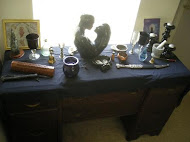Picture from The Mystic Eye
The name of the gemstone peridot is believed to come from either the Arabic word faridat meaning "gem" or the French word peritot meaning "unclear." It is also claimed to be derived from the Greek word 'peridona', which means something like 'to give richness'. The peridot is one of the few gemstones which comes in one color only. The rich, green color with the slight tinge of gold is caused by very fine traces of iron - the intensity of the color depends on the amount of iron actually present. The color itself can vary over all shades of yellowish green and olive, and even to a brownish green. Peridot cat's eyes and star peridot are particularly rare and precious. The most beautiful stones come from the border area between Pakistan and Afghanistan. However, the peridot as a gemstone also exists in Myanmar, China, the USA, Africa and Australia. Stones from East Burma, now known as Myanmar, have a vivid light green and fine inclusions with a silky shine to them. Peridot from Arizona, where it is popularly used in native American jewelry, often has somewhat yellowish or gold-brown nuances. The earliest recorded production of peridot was in about 70 A.D. from St. Johns Island in the Red Sea, about 54 kilometers off the coast of Egypt, which was "lost" for centuries and rediscovered about1900. Almost all of the earliest known peridot gems came from this location and small amounts of material are still being produced from there today. Peridot was mined for over 3,500 years on St Johns Island, and It has now been mostly exhausted. Having said that, the peridot is also a thoroughly modern gemstone, for it was not until a few years ago that peridot deposits were located in the Kashmir region; and the stones from those deposits, being of an incomparably beautiful color and transparency, have succeeded in giving a good polish to the image of this beautiful gemstone, which had paled somewhat over the millennia.
Peridot has been adored since ancient times and has been valued for centuries - the peridot is a very old gemstone, and one which has become very popular again today. It is so ancient that it can be found in Egyptian jewelry from the early 2nd millennium B.C., and ancient papyri record the mining of these stones as early as 1500 BC. Ancient Egyptians knew it as “the gem of the sun,” although they believed its seekers might not find it in sunlight. (Because of their brightness in the desert sun, the stones were supposedly invisible by daylight.) The ancient Romans too were fond of this gemstone and esteemed its radiant green shine, which does not change even in artificial light, but rather the stone glows a brilliant green. For that reason they nicknamed it the 'emerald of the evening' and rings of peridot were worn to relieve depression. People in the Middle Ages wore peridot to gain foresight and divine inspiration. Legend has it that pirates favored peridot to protect them against evil. It was greatly prized by Egyptian Kings, and some of Cleopatra's emeralds were in fact peridots. Anciently, large chunks of peridot were found in Hawaii, where peridot symbolizes the goddess Pele's tears. (Some Hawaiian beaches are packed with tiny grains of peridot that are too small to cut.) These large chunks found their way to the the Egyptians, who made small drinking vessels out of them. They were used in rituals, and the priests would drink soma from them. The soma would put them in touch with the nature goddess, Isis. (Legend has it that King Solomon traded many cedar trees from Lebanon for 12 soma drinking cups and 144 liters of soma. The Egyptians made this trade for ramp logs to build their pyramids at Gisa. King Solomon was said to have been made wise and enlightened by the drinking of soma from the peridot cups.)
In the middle ages, Europeans brought peridot stones back from the Crusades to decorate church plates and robes. and it can be found in Europe in medieval churches, where it adorns many a treasure. An example - one of the shrines in Cologne Cathedral, where one famous large peridot gem adorning the shrine of the Three Holy Kings in the cathedral was for centuries, believed to be an emerald. It was only identified as peridot late in the last century.) Once upon a time, ecclesiastical treasures in European cathedrals included some fine, large peridots, but wars and pillage have dispersed many of them. Peridot was also known to ancient Hebrews and is listed both as one of the stones used by Aaron and found in the text of the apocalypse (Revelations). Several experts believe that the second gemstone in Aaron’s breastplate was a peridot. (The breast plates of Solomon and the High Priest Aaron were said to carry them among them 12 stones to protect them from wounds and death in battle. These 12 stones were credited with the showing of true spiritual teaching by creating miracles of healing performed by the high priests.) During the baroque period, the rich green gemstone once again enjoyed a brief heyday, and then it somehow faded into oblivion.
This beautiful stone is worn or carried for general healing purposes, and is said to bring healing and vitality to the whole body. Peridot increases strength & physical vitality, protects against nervousness and aids in healing hurt feelings. Because of it’s yellowish green color, peridot has been believed to cure diseases of the liver and difficulties with digestion as well as protect lungs, sinuses, and wrists from illness and injury. Ground peridot, taken internally, was once used as a treatment for asthma. As with other gemstones, the color of the peridot stone is directly related to parts of the body that it can be of aid to. It aids in physical detoxification and helps problems with the kidneys, bladder, gall bladder, and the stomach. Peridot heals such illnesses as ulcers, constipation, and irritable bowel syndrome. It is also useful in helping to heal insect bites. Peridot has a tonic effect- it heals and regenerates tissues, strengthens the metabolism and benefits the skin. It aids the heart, thymus, and spleen. If placed on the abdomen, it aids in giving birth by strengthening the muscle contractions while lessening the pain. Peridot is also helpful in treating skin diseases and difficulties associated with the adrenal glands and endocrine systems. It is also used to treat fevers. Legends credit peridot strengthening the eyes, and several sources say that in ancient times, cups or other vessels made of peridot were used in healing because medicinal liquids drunk from them were more effective.
Peridot is also very beneficial when it comes to treating psychological afflictions as well. It is a wonderful stone to help someone who is going through depression. It is a stone of lightness that counters the effects of negative emotions. It has the ability to balance the process of emotional release and detoxifies negative emotions, bringing them to comfortable levels. Peridot fosters emotional balance, security, and inner peace. It soothes nervousness, heals emotional and physical pain, and lightens suffering. Because it is calming to the nervous system, peridot is also useful in promoting sleep. Peridot banishes lethargy, which can attack someone who is experiencing depression. The stone’s energy balances bipolar disorders. It also brings about necessary change, which is much needed to someone who is depressed. Peridot also has other psychological effects and uses. It can help one overcome hypochondria. It can greatly improve difficult relationships. It treats phobias, particularly those associated with fears of the dark, becoming like a security blanket to a small child.
It is used to stimulate the heart and solar plexus chakras allowing openness and acceptance in the intellectual pursuit of matters of the heart. (For specific chakra work, because it acts to seal the aura, it is suggested that peridot be removed while working on chakras other than the heart and solar plexus.) Peridot opens, cleanses and activates the heart, which can help one to release old baggage. All burdens, guilt and obsessions become cleared and a new psychological clarity and feeling of well-being begin. Peridot teaches that holding onto the past is counter productive. It shows you how to detach yourself from outside influences and how to look to your own higher energies for guidance. It assists in moving forward rapidly in therapeutic situations. It also helps you understand your destiny and spiritual purpose, helping you attain your full potential. All in all, the stone sharpens the mind and opens it to new levels of awareness.
Throughout history, there have been many legends that state the strong magical power that peridot possesses. Legend says that if the gem is set in gold, it will develop its full potential as a talisman and will have the power to dispel terrors of the night, fears and bad dreams. However, according to Pliny The Elder, the Great Roman authority on such matters, for peridots to work their strongest magic, they must be worn on the right arm. He also wrote that peridot is "dull during daylight hours but will glow like a hot coal by night." Peridot represents wealth and financial success (think of its green hue) and also attracts romance. It has been long considered to be an aid to friendship and supposedly frees the mind of envious thoughts. It is also supposed to protect the wearer from the evil eye and with bringing happiness, good cheer and attract lovers. A piece of peridot upon which was carved an ass was believed to assist a person with a skill or prophesy, and the engraving of a totem of a vulture allowed the stone to have control over various demonic spirits as well as the winds. It assists in finding what is lost, and strengthens ESP abilities, and has been said to make a shield of protection around the body of any wearer. According to folklore, peridot brought power and influence to its owner, as well as bringing good luck, peace, and success. Its powers include health, protection, and sleep. Peridot is said to attract love while also soothing nerves and dispelling negative emotions, and it is believed to promote sleep when worn to bed.. Peridot, further, helps to heal a bruised ego by assisting in the lessening of jealousy, anger, (it will calm a raging anger) and fear, by inspiring happiness with oneself and delight in ones own nature. Peridot is used to help dreams become a reality. The deep green hue of the peridot also suggests a connection in wealth-attracting.
The stone emits a warm and friendly energy and can be used to magnify the inner aspects of any situation. It helps one to understand ones own inner life changes, and helps a person see their own light and recognize that they are deserving of love. It also helps those who feel they have little personal power, as working with the stone, or keeping one with you, will give you that extra boost you might need. If you want to start a growth period, meditate with peridot in your left hand (the receiving one). Visualize the bright color (and the energy that accompanies it) coursing through your chakras, clearing and grounding them. Then see it clearing and grounding your aura. Tell the universe that you are ready for growth, and trust the universe to do the rest. It's ok to then visualize your chakras returning to their normal colors, it is just more intense this way! (The brighter, and more yellow the color, the more intense the experience. This is the stone of adventure. We never know what we will find, but it sure is a heck of a ride!)
Sources:
About.com
Mystical Sculptress
Encyclopedia of Gemstones
Jewels For Me
CrystalsandJewelry
Disclaimer: No one involved in this blog or its contents may be held responsible for any adverse reactions arising from following any of the instructions/recipes on this list. It is the reader's personal responsibility to exercise all precautions and use his or her own discretion if following any instructions or advice from this blog.
















No comments:
Post a Comment